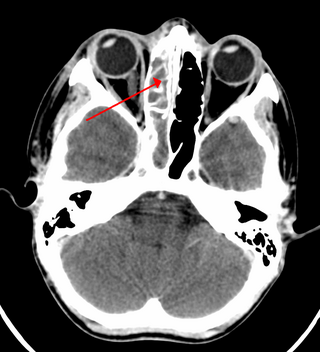
Sinusitis, also known as rhinosinusitis, is inflammation of the mucous membranes that line the sinuses resulting in symptoms that may include thick nasal mucus, a plugged nose, and facial pain. Other signs and symptoms may include fever, headaches, a poor sense of smell, sore throat, a feeling that phlegm is oozing out from the back of the nose to the throat along with a necessity to clear the throat frequently and frequent attacks of cough.

An upper respiratory tract infection (URTI) is an illness caused by an acute infection, which involves the upper respiratory tract, including the nose, sinuses, pharynx, larynx or trachea. This commonly includes nasal obstruction, sore throat, tonsillitis, pharyngitis, laryngitis, sinusitis, otitis media, and the common cold. Most infections are viral in nature, and in other instances, the cause is bacterial. URTIs can also be fungal or helminthic in origin, but these are less common.
Area codes 705, 249, and 683 are telephone area codes in the North American Numbering Plan (NANP) for most of northeastern and central Ontario in Canada. Area code 705 was created in a 1956 area code split from portions of the 613 and 519 numbering plan areas. After a reduction in geographic coverage in 1962, the numbering plan area was assigned a second area code, 249, in 2011 to form an overlay numbering plan. A third area code, 683, was added in June 2022.
Area codes 519, 226, 548, and 382 are overlay telephone area codes in the North American Numbering Plan (NANP) for most of southwestern Ontario.

Area code 701 is a telephone area code in the North American Numbering Plan (NANP) for the U.S. State of North Dakota. It is one of the 86 original North American area codes created by AT&T in 1947, and continues to be the only area code in North Dakota, one of eleven states with only one area code.

Area code 403 is a telephone area code in the North American Numbering Plan (NANP) for the Canadian province of Alberta. The numbering plan area encompasses the southern third of the province, which includes the Calgary area. This numbering plan area is also served by area codes 587, 825, and 368, which form a complex overlay for all of Alberta.
Area codes 506 and 428 are the telephone area codes in the North American Numbering Plan (NANP) for the Canadian province of New Brunswick. Area code 506 was created in 1955 in a split of numbering plan area (NPA) 902. Area code 428 was added to the same numbering plan area in 2023 to form an overlay plan of the area.

Area code 604 is a telephone area code in the North American Numbering Plan for southwestern British Columbia, Canada. The numbering plan area comprises the Lower Mainland, Sunshine Coast, Howe Sound / Sea to Sky Corridor, Fraser Valley and the lower Fraser Canyon regions. The major city is Vancouver. The area code is one of the nine original North American area codes assigned to Canada in 1947.
Chronic atrophic rhinitis, or simply atrophic rhinitis, is a chronic inflammation of the nose characterised by atrophy of nasal mucosa, including the glands, turbinate bones and the nerve elements supplying the nose. Chronic atrophic rhinitis may be primary and secondary. Special forms of chronic atrophic rhinitis are rhinitis sicca anterior and ozaena. It can also be described as the empty nose syndrome.
The chancellor was a semi-formally designated office position for a number of high-level officials at one time during the Tang dynasty of China. This list also includes chancellors of the short-lived Wu Zhou dynasty, which is typically treated as an interregnum of the Tang dynasty by historians.
This page is based on this
Wikipedia article Text is available under the
CC BY-SA 4.0 license; additional terms may apply.
Images, videos and audio are available under their respective licenses.




